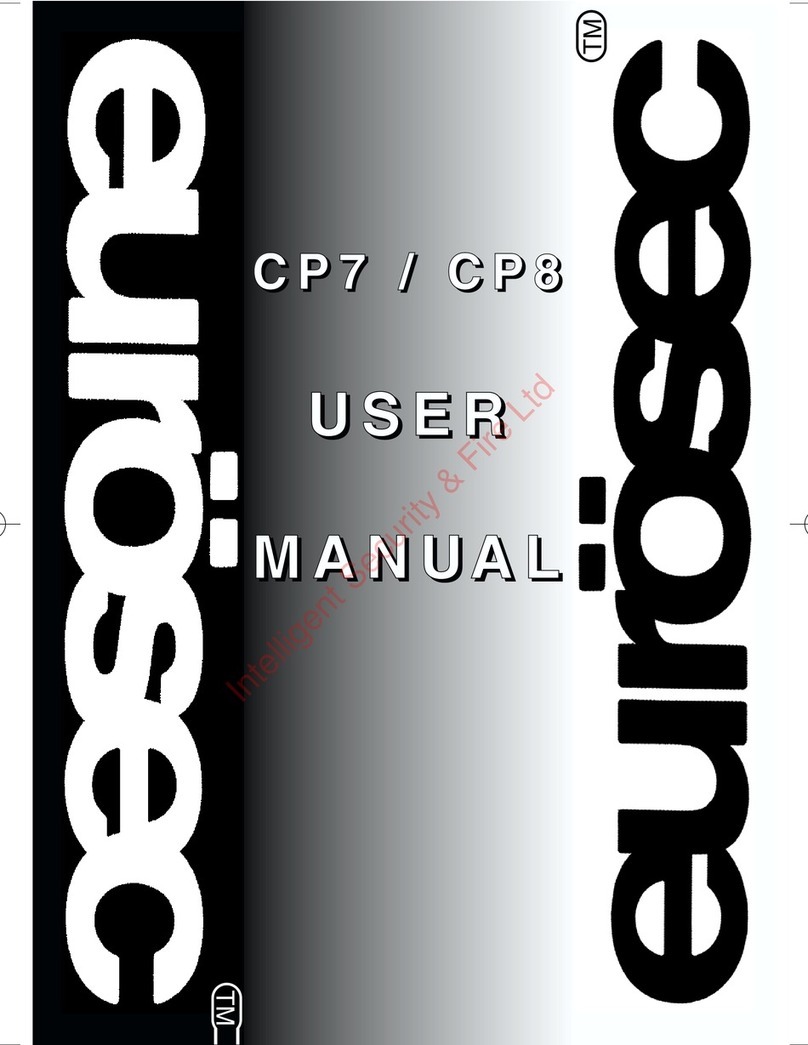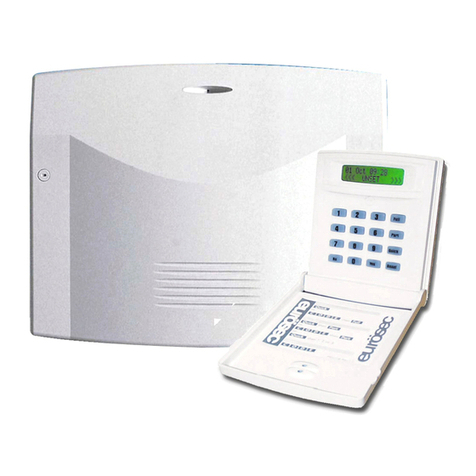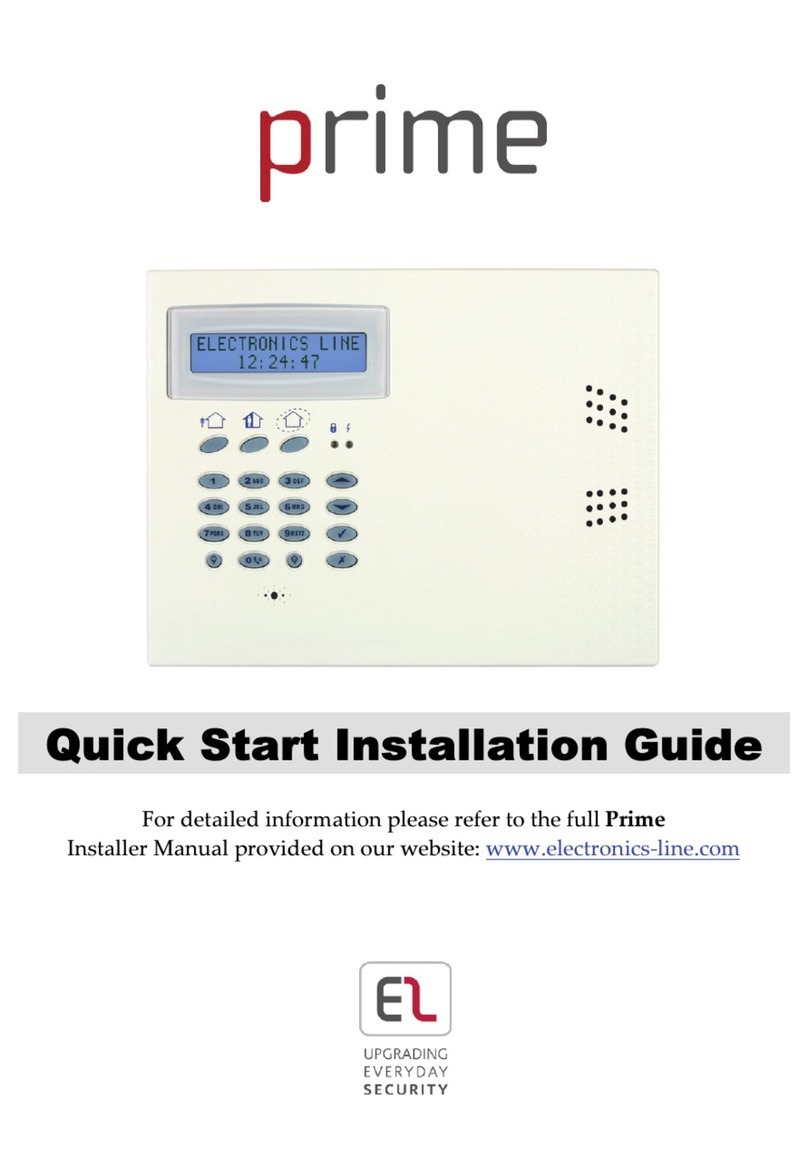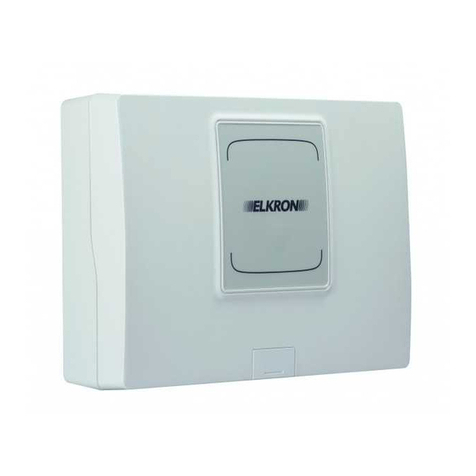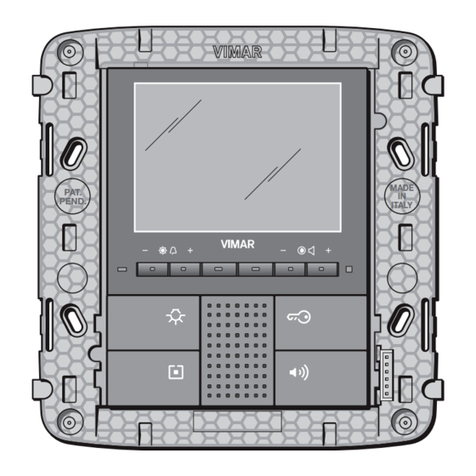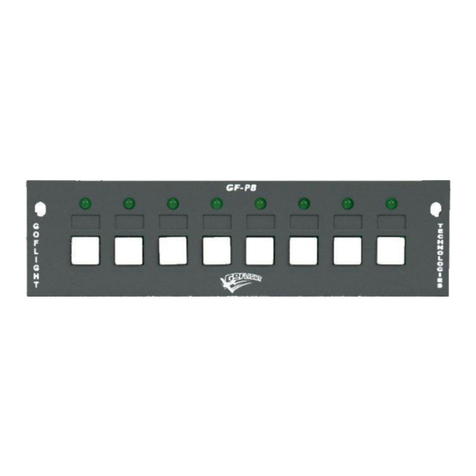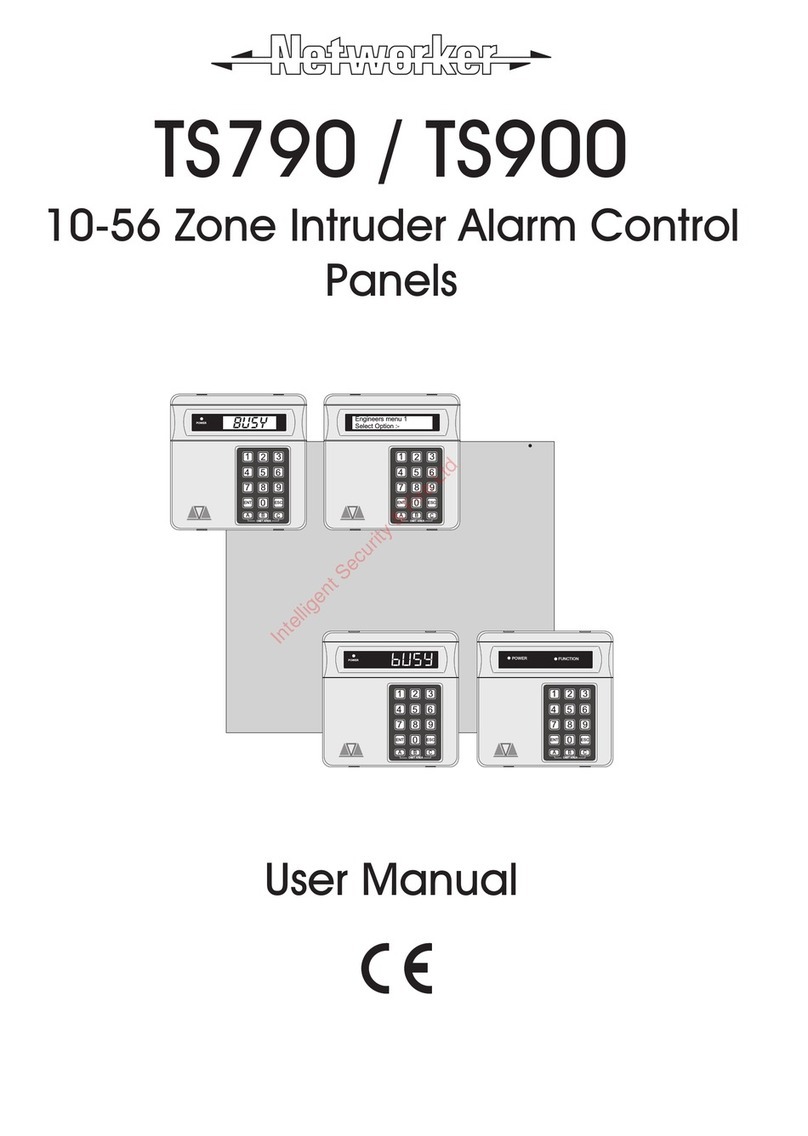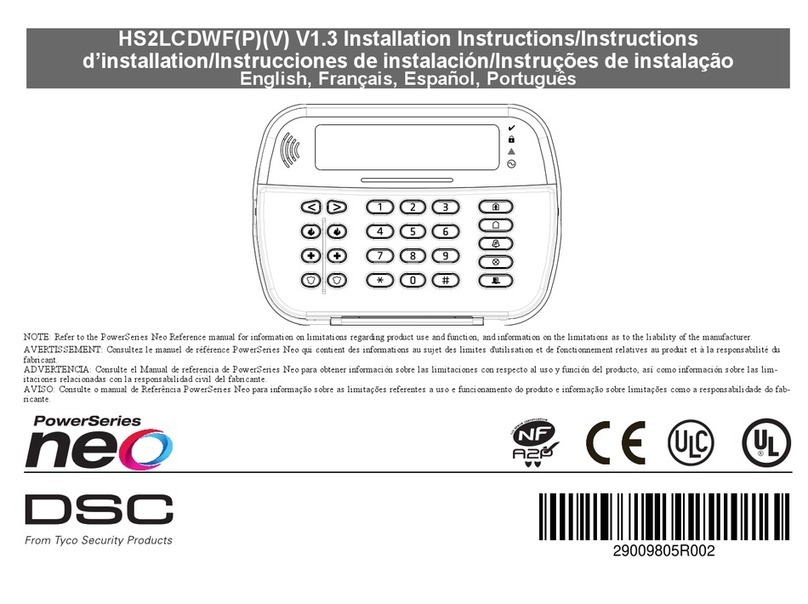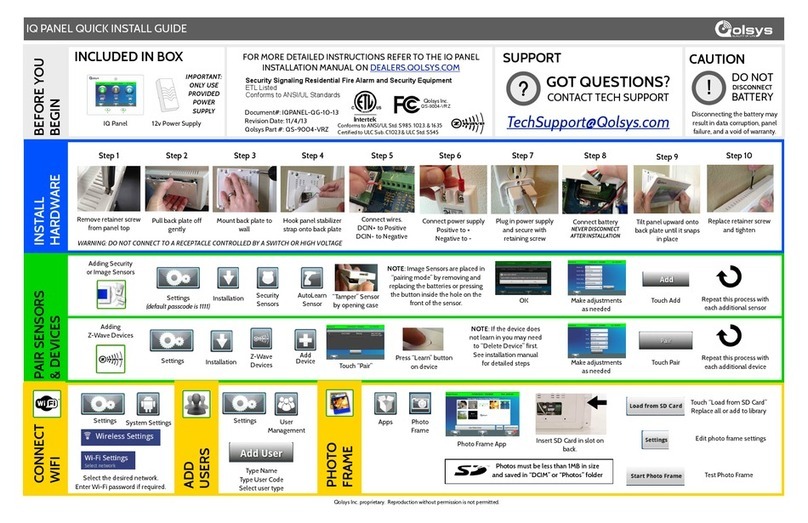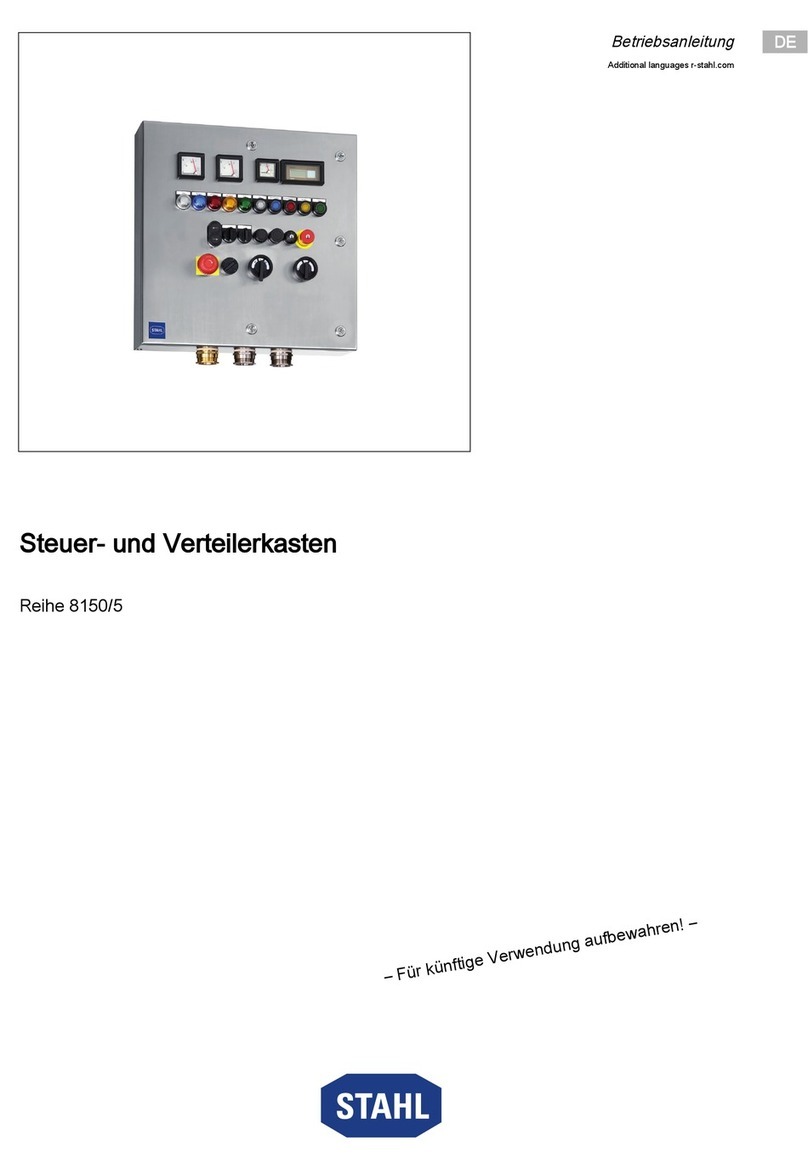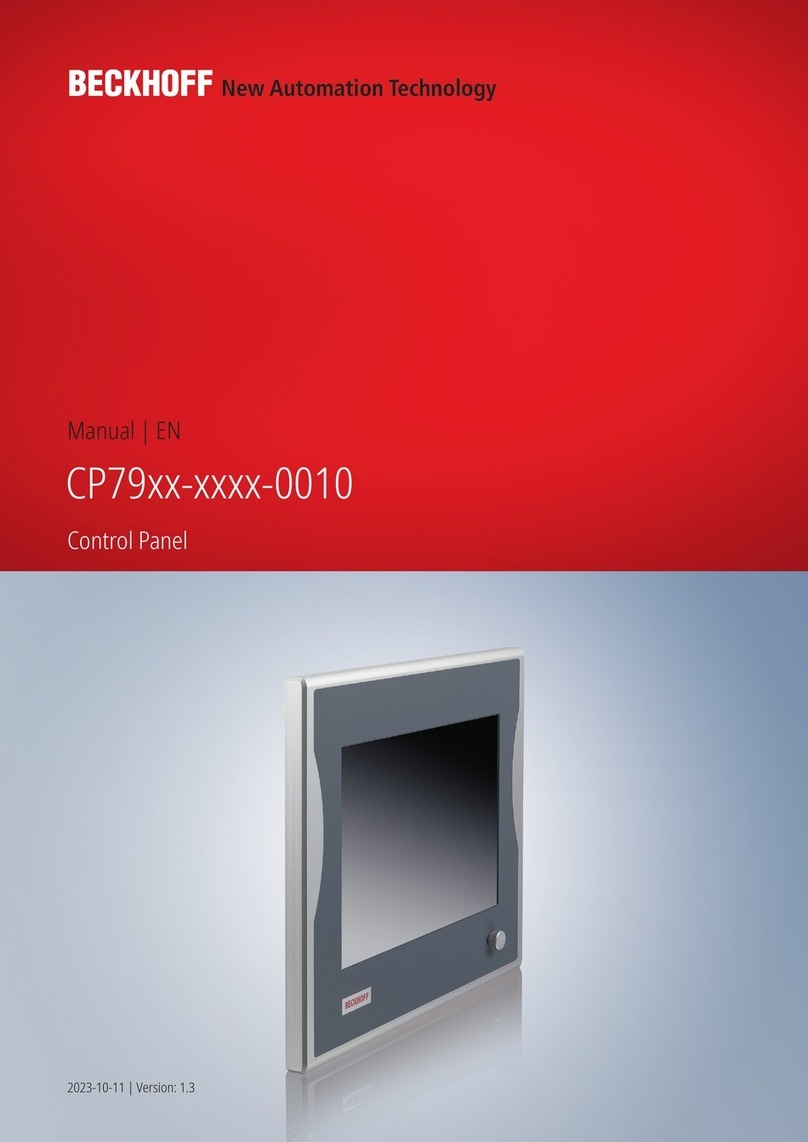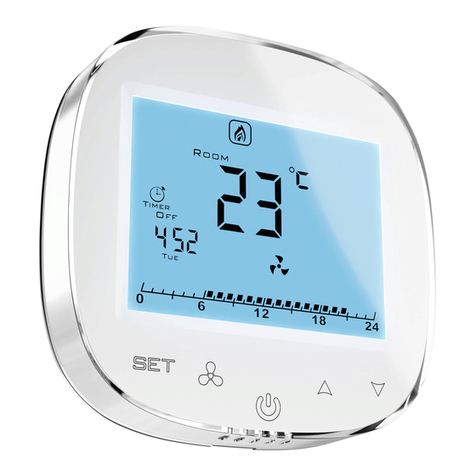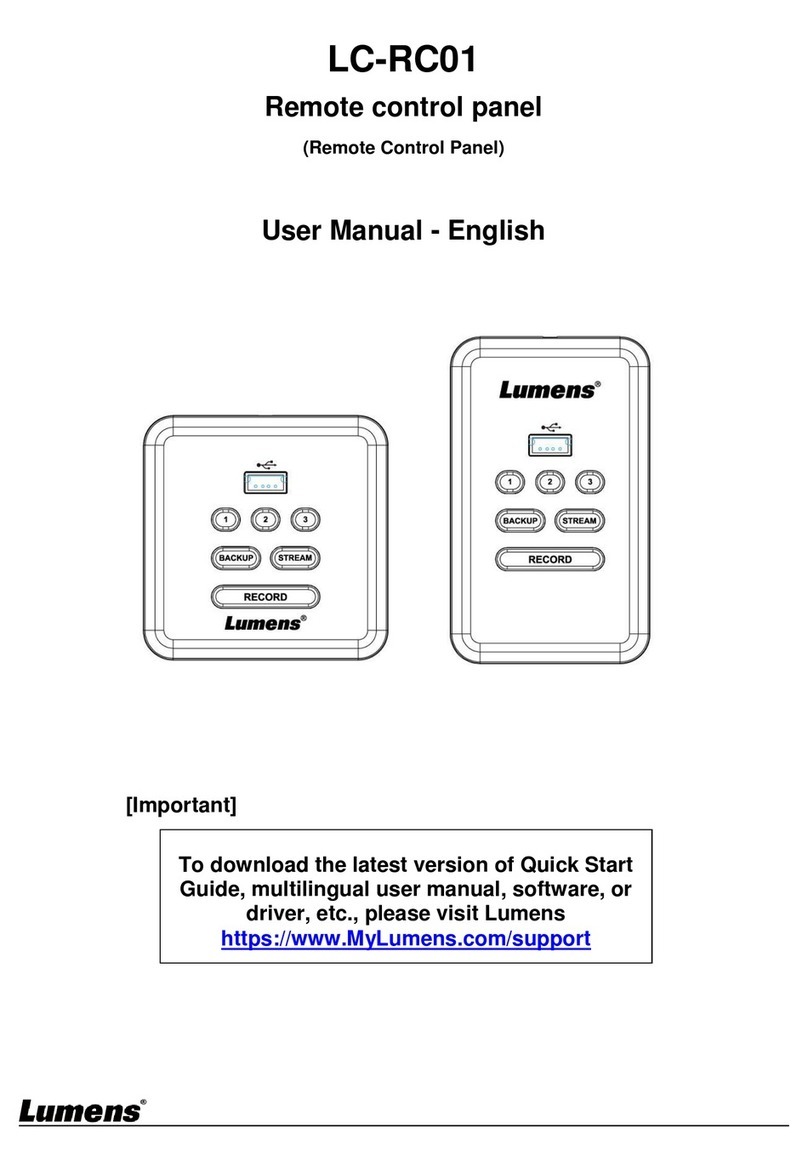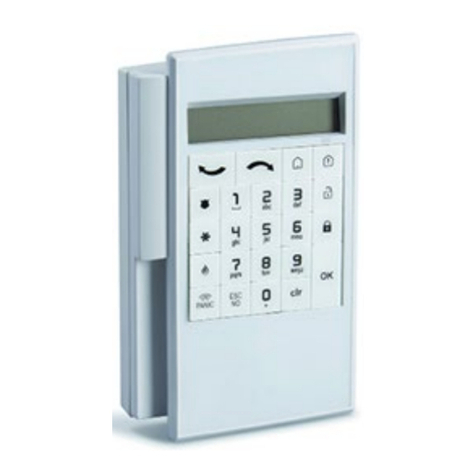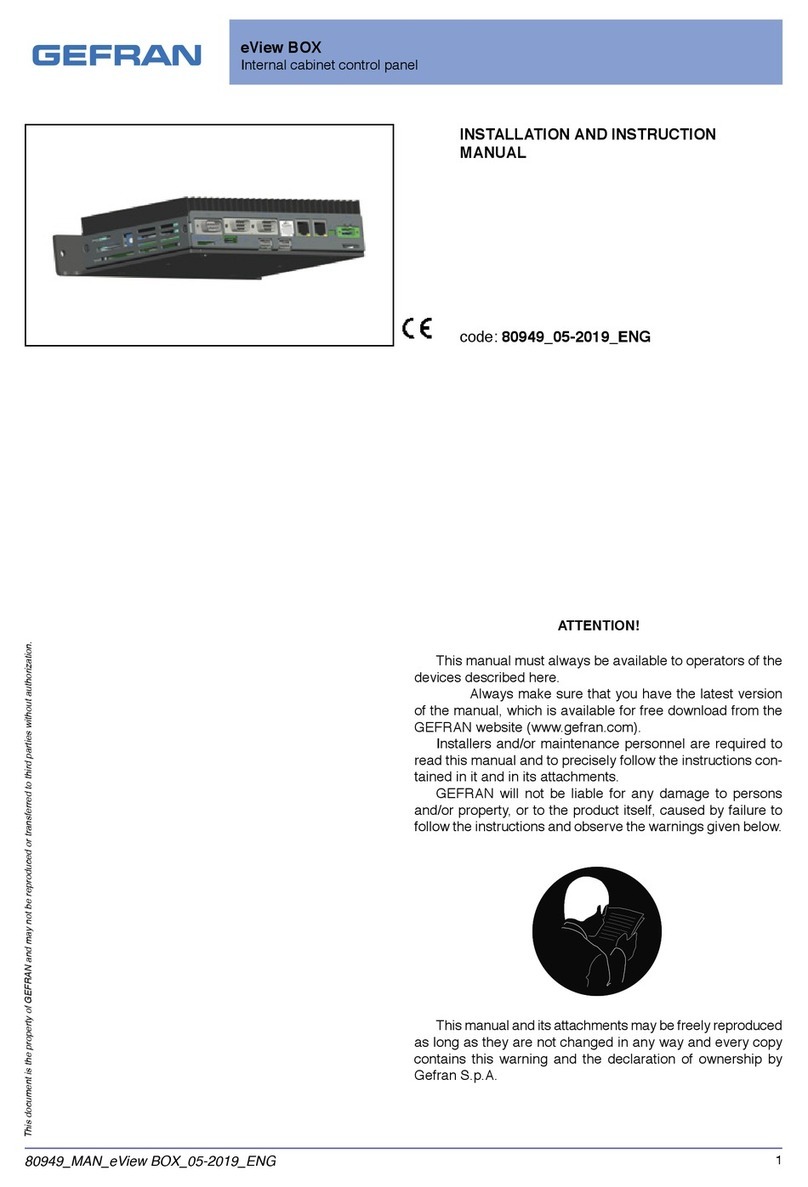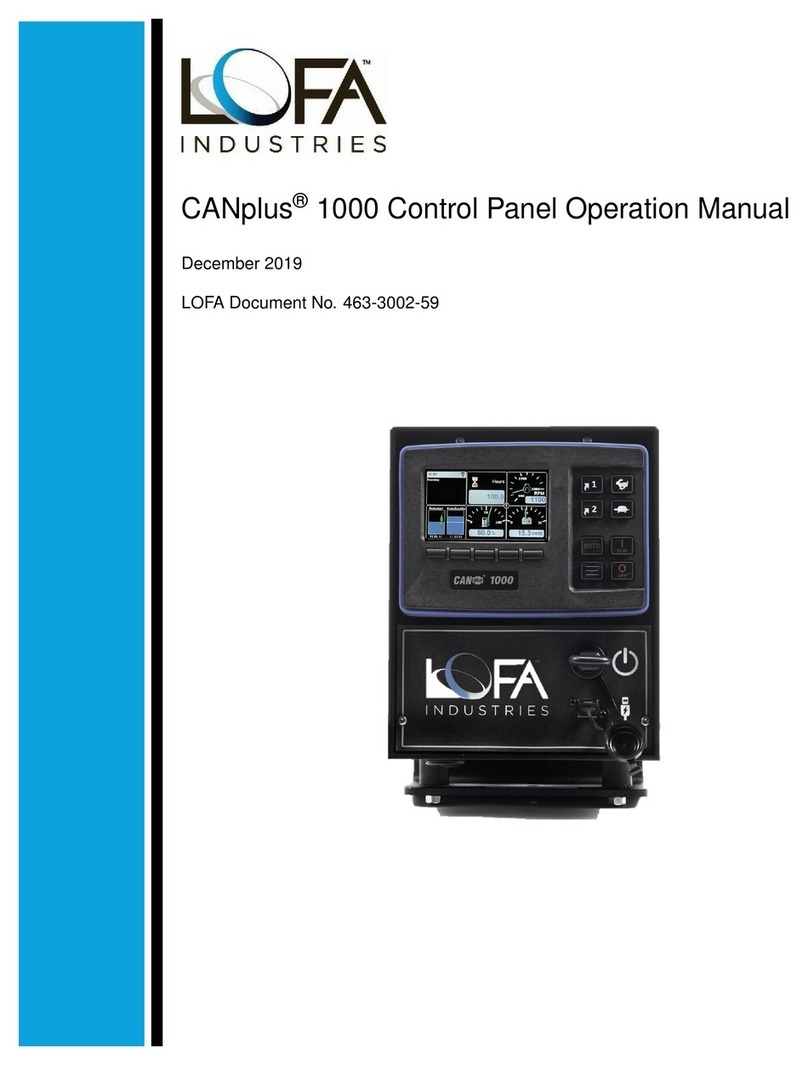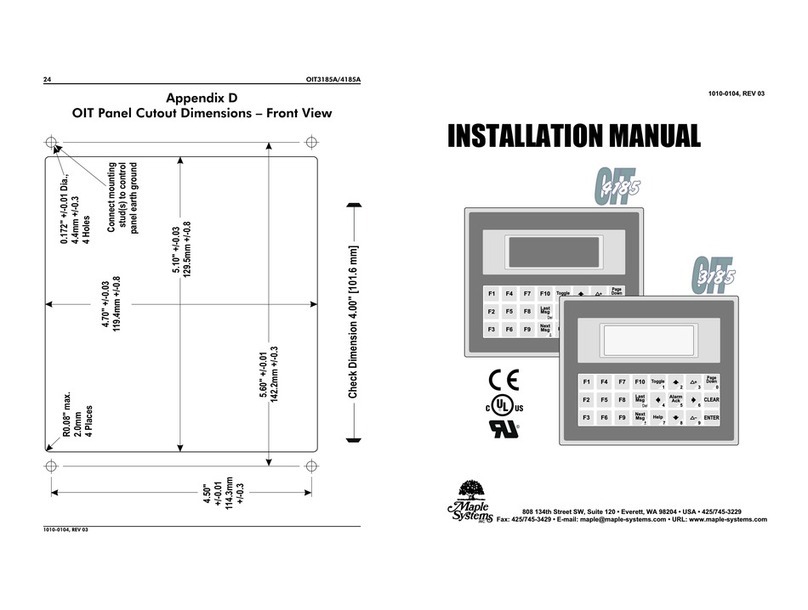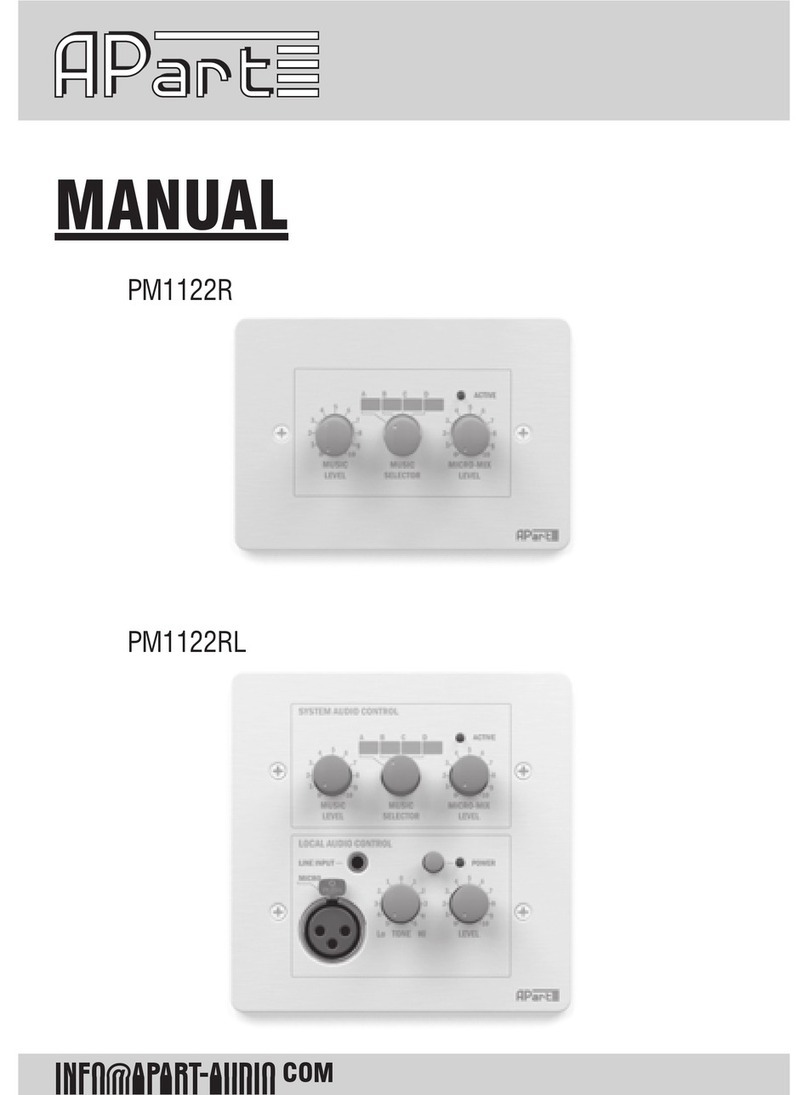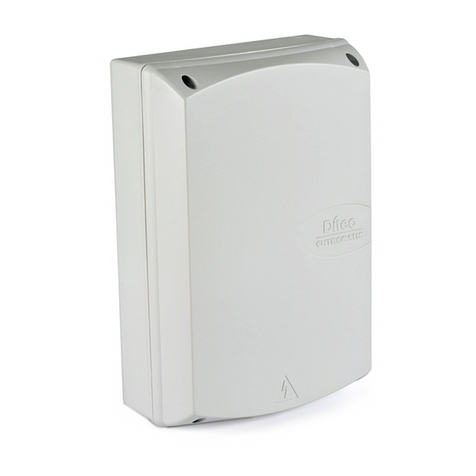EUROSEC CP8L User manual

CC
CCPP
PP88
88LL
LL
LL
LLCC
CCDD
DD
II
IINN
NNSS
SSTT
TTAA
AALL
LLLL
LLAA
AATT
TTII
IIOO
OONN
NN
II
IINN
NNSS
SSTT
TTRR
RRUU
UUCC
CCTT
TTII
IIOO
OONN
NNSS
SS
TM
TM
ENGINEER.qxd 16/10/01 13:14 Page 1

ENGINEER.qxd 16/10/01 13:14 Page 2

Contents
Introduction . . . . . . . . . . . . . . . . . . . . . . 2
Mains Safety . . . . . . . . . . . . . . . . . . 2
Good Working Practice . . . . . . . . . . 2
Installation . . . . . . . . . . . . . . . . . . . . . . . 3
Control Panel Location . . . . . . . . . . 3
Mounting the Control Panel . . . . . . . 3
Mounting the RKP . . . . . . . . . . . . . . 3
Wiring . . . . . . . . . . . . . . . . . . . . . . . . . . 4
General Detector Wiring . . . . . . . . . 4
Wiring Global Tampers . . . . . . . . . . 4
Wiring Contacts . . . . . . . . . . . . . . . 4 - 5
Wiring Passive Infra-Red Detectors . 5
General Bell Box Wiring . . . . . . . . . 6
Bell Tamper Ring . . . . . . . . . . . . . . . 6
Sample Bell Box Connections . . . . . 6 - 7
Wiring Notes . . . . . . . . . . . . . . . . . . 8
Control Panel Connections . . . . . . . 8
Programming . . . . . . . . . . . . . . . . . . . . . 9
Terminology . . . . . . . . . . . . . . . . . . 9
Engineer Programming Mode . . . . .10
Programmable Engineer Options . . .11 - 13
Engineer / User Mode . . . . . . . . . . .14
Engineer Reset . . . . . . . . . . . . . . . .15
Anti-Code Reset . . . . . . . . . . . . . . .15
Resetting to Factory Defaults . . . . . .16
Changing the Engineer code . . . . . .21
Troubleshooting . . . . . . . . . . . . . . . . . .17 - 18
Specifications . . . . . . . . . . . . . . . . . . . .19
System Details . . . . . . . . . . . . . . . . . . .20
ENGINEER.qxd 16/10/01 13:14 Page 3

II
IInn
nnss
sstt
ttaa
aall
llll
llaa
aatt
ttii
iioo
oonn
nn
MM
MMaa
aann
nnuu
uuaa
aall
llee
eeuu
uurr
rroo
ooss
ssee
eecc
cc
II
IInn
nntt
ttrr
rroo
oodd
dduu
uucc
cctt
ttii
iioo
oonn
nn
Introduction
The eurosec control panel is supplied as a blank fronted end station complete with LCD RKP.
Up to 3 additional may be fitted if required. The unit is fully programmable by the installation and
comes pre-programmed with a set of factory defaults that will suit most installations. Seven
programmable zones are available on the CP7 and eight zones on the CP8
IMPOR
IMPORT
TANT!
ANT!
Input: AC230V +/-10% ~50Hz 200mA Max. 49W Max
For Indoor Use Only
Nominal Temp Range: 0° - 50° Centigrade
This equipment is intended only for use as a Security Alarm Control Panel. Adequate ventilation
away from heat and humidity must be provided. The unit must be fixed securely to a non-
flammable surface using suitable fixings.
All mains wiring must be to BS7671 (1992) IEEE wiring regulations (or appropriate international
regulatory standards). See relevant section within this manual for connection to mains supply.
Provision is provided for an earth connection within the mains connection block, this is for the
protection of the wiring and is not a functional part of the unit.
All low voltage (alarm) wiring must be to the appropriate international regulatory standards and
comply to good wiring practice.
Replacement fuses should be of the same type and rating conforming to IEC127.
The maximum current draw from the unit for all output combinations must not exceed 1Amp.
The unit is intended for use with a suitable re-chargeable battery permanently connected to the
appropriate terminals.
Mains Safety
The main unit must be connected to a mains supply via a 3Amp unswitched fused spur. This
must be carried out by a suitably qualified electrician. If you are in any doubt please contact your
local electricity company for advice.
Good Working Practice
The reliability of any security system may be greatly enhanced by following a few good working
practices. Do not connect the mains supply to any rings that have fridges, freezers or
fluorescent lights connected to them. When running low voltage alarm cables avoid running
parallel to mains wiring, if you do so separate by a least nine inches. When crossing mains
cables do so at 90°
PP
PPaa
aagg
ggee
ee
22
22
ENGINEER.qxd 16/10/01 13:14 Page 2

ee
eeuu
uurr
rroo
ooss
ssee
eecc
ccII
IInn
nnss
sstt
ttaa
aall
llll
llaa
aatt
ttii
iioo
oonn
nn
MM
MMaa
aann
nnuu
uuaa
aall
ll
Control Panel & RKP Location
Consideration needs to be given to the location of the Control Panel & LCD RKP with regards
to-
The surface that the unit(s) are to be fixed to should be firm, vibration free, damp free and fire
resistant.
Access for the routing of mains and low voltage wiring.
Service Access to the unit(s).
Operation of the keypad.
Operation of ACE remote keyfobs(if fitted).
Readability of the LCD RKP display(s).
Mounting the Control Panel
Unscrew the two cover retaining screws and remove the front cover.
The PCB is held in place by two lower PCB retaining lugs and two upper sprung latches.
Push both upper latches upwards and pull the PCB forward and upward in one movement.
With the PCB removed from its retainers offer the unit to the wall and mark for the three fixing
points. Under no circumstances should you drill through the base.
Remove any knockouts that are required from the base and also the cover screw caps from
the moulding pips in the base and retain them for use after fixing the front cover in place.
Using suitable rawl plugs and 3 No.8 x 1.5” (min) screws fasten the base to the wall but do
not tighten until all cabling is in place.
Mounting the RKP
Lower the front cover of the RKP and unscrew the single cover fixing screw.
Offer the RKP base to the wall and mark the three fixing positions. Under no circumstances
should you drill through the base.
Remove one of the cover screw caps and retain for use after fixing the front cover.
Using suitable rawl plugs and 3 No.6 x 1” (min) screws fasten the base to the wall offering
the connecting cable through a suitable aperture in the base as you do so.
Wire the LCD RKP as shown in the wiring section of this manual.
Replace the cover and tighten the cover fixing screw.
When finished put the cover screw cap in on the cover screw and push into place.
PP
PPaa
aagg
ggee
ee
33
33
II
IInn
nnss
sstt
ttaa
aall
llll
llaa
aatt
ttii
iioo
oonn
nn
ENGINEER.qxd 16/10/01 13:14 Page 3

II
IInn
nnss
sstt
ttaa
aall
llll
llaa
aatt
ttii
iioo
oonn
nn
MM
MMaa
aann
nnuu
uuaa
aall
llee
eeuu
uurr
rroo
ooss
ssee
eecc
cc
General Detector Wiring
We would strongly suggest that you adopt a colour scheme for the detector wiring of your
system. This will enable you to quickly determine the source of any problems that may occur.
The security industry does not have recommended colour schemes because of the nature of
the wiring, one suggested scheme is given below.
Red/Black.................... Alarm Pair
Green.......................... + Supply
White........................... - Supply
Yellow/Blue.................. Tamper Pair
Wiring Global Tampers
One pair of tamper terminals is provided on the control panel PCB for tamper protection of the
zones. This is termed as a Global Tamper, one simple method of wiring Global Tampers is
shown in Fig. 1 below.
Fig. 1 Wiring Global Tampers
Wiring Contacts
Many types of contacts are available and fall in to two categories, surface or flush. The method
of operation is the same for both. One half of the contact is fitted to the door or window frame,
inside is a reed switch that is pulled together in the presence of a magnetic field. The other half
that is fitted to the opening section of the door or window contains the magnet. These devices
are referred to as normally closed (NC or N/C). The gap allowed for reliable operation will vary
(usually between 5mm & 20mm) dependant on the model used, you should check this
specification with your supplier before fitting.
In Figs. 2 & 3 we have used 5 screw surface contacts for clarity of the illustration.
PP
PPaa
aagg
ggee
ee
44
44
WW
WWii
iirr
rrii
iinn
nngg
gg
ENGINEER.qxd 16/10/01 13:14 Page 4

ee
eeuu
uurr
rroo
ooss
ssee
eecc
ccII
IInn
nnss
sstt
ttaa
aall
llll
llaa
aatt
ttii
iioo
oonn
nn
MM
MMaa
aann
nnuu
uuaa
aall
ll
Fig. 2 Wiring Single Contact
Fig. 3 Wiring Double Contact (on the same zone)
Wiring Passive Infra-Red Detectors
It is essential when using Passive Infra-Red Detectors that you refer to the manufacturers
instruction as to the positioning and settings of the detector. This section is intended as a
guide to the wiring of the detectors.
Fig. 4 Wiring Single PIR
Fig. 5 Wiring Double PIR (on same zone)
PP
PPaa
aagg
ggee
ee
55
55
WW
WWii
iirr
rrii
iinn
nngg
gg
Notes
Positions of terminals will vary
according to make.
All PIR wiring diagrams apply
also to Dual Technology
Detectors and Vibration sensors.
ENGINEER.qxd 16/10/01 13:14 Page 5

II
IInn
nnss
sstt
ttaa
aall
llll
llaa
aatt
ttii
iioo
oonn
nn
MM
MMaa
aann
nnuu
uuaa
aall
llee
eeuu
uurr
rroo
ooss
ssee
eecc
cc
General Bell Box Wiring
As with the detector wiring we would suggest that you adopt a standard for your Bell Box wiring,
the colour scheme below is provided as a suggestion only.
Hold Off Supply +................. Red
Hold Off Supply - .............. .. Black
Trigger................................... Blue
Tamper Return...................... Yellow
Strobe +................................ Green
Strobe -................................. White
Bell Tamper Ring
It should be noted that many bell boxes that are fitted with rechargable batteries will sound when
the battery is connected. This connection may take the form of manually connecting the battery
wires to terminals or placing a link into the On position. Dependant on the bell box being used
the sounder may sound when the battery is connected unless power from the control panel is
connected or the bell box tamper is closed or in some cases both. Most bell boxes produce
high volume noise adequate ear protection MUST be used.
Sample Bell Box Connections
Below is shown general and sample bell box connections for some of the popular bell boxes that
are available.
PP
PPaa
aagg
ggee
ee
66
66
WW
WWii
iirr
rrii
iinn
nngg
gg
Bell +
Bell -
Bell Hold -
SAB TMP
Strobe +
Strobe -
Tamper Return
Supply -
Bell Trigger
Supply +
Strobe -
Strobe +
eurosec control
panel terminals
General bellbox
connections
Check bellbox
terminal positions
Tamper Feed
Bell +
Bell -
Bell Hold -
SAB TMP
Strobe -
TMPR
12v
Bell SW-
0V
STR SW-
eurosec control
panel terminals
Novagard Delta
bellbox connections
Check bellbox
terminal positions
Bell +
Bell -
Bell Hold -
SAB TMP
Strobe -
R-TMP
0V
S-
12V+
ST-
eurosec control
panel terminals
Delta E, Novagard 1E & 6
bellbox connections
Check bellbox
terminal positions
TMP-F
Bell +
Bell -
Bell Hold -
SAB TMP
Strobe +
Strobe -
R Tamper Return
-12v Supply
Bell SW-
+12v Supply
Strobe -
Strobe +
eurosec control
panel terminals
Novagard 2&4
bellbox connections
Check bellbox
terminal positions
F Tamper Feed
Fig.6A Fig.6B
Fig.6C Fig.6D
ENGINEER.qxd 16/10/01 13:14 Page 6

ee
eeuu
uurr
rroo
ooss
ssee
eecc
ccII
IInn
nnss
sstt
ttaa
aall
llll
llaa
aatt
ttii
iioo
oonn
nn
MM
MMaa
aann
nnuu
uuaa
aall
ll
PP
PPaa
aagg
ggee
ee
77
77
WW
WWii
iirr
rrii
iinn
nngg
gg
Bell +
Bell -
Bell Hold -
SAB TMP
Strobe -
AT Return
Supply -VE
Siren Trigger -VE
Supply +VE
STR -VE
eurosec control
panel terminals
CQR Integra HS
bellbox connections
Check bellbox
terminal positions
Common
(Select AT Return)
-VE
Bell +
Bell -
Bell Hold -
SAB TMP
Strobe +
Strobe -
Tamper
Supply -
Trigger -
Supply +
Strobe -
Strobe +
eurosec control
panel terminals
C&K Securiguard
bellbox connections
Check bellbox
terminal positions
Tamper
Bell +
Bell -
Bell Hold -
SAB TMP
Strobe -
TR
H-
-R
H+
ST
eurosec control
panel terminals
Elmdene Prima
bellbox connections
Check bellbox
terminal positions
Bell +
Bell -
Bell Hold -
SAB TMP
Strobe -
C
D
B
A
S
eurosec control
panel terminals
Texecom Azura
bellbox connections
Check bellbox
terminal positions
Bell +
Bell -
Bell Hold -
SAB TMP
Strobe -
A/T Ret Sig
Hold Off -ve
Siren Trig
Hold Off +ve
Strobe Trig
eurosec control
panel terminals
CQR Cequra
bellbox connections
Check bellbox
terminal positions
Bell +
Bell -
Bell Hold -
SAB TMP
Strobe +
Strobe -
T
A
B
D
Strobe -
Strobe +
eurosec control
panel terminals
ADE Sonnade
bellbox connections
Check bellbox
terminal positions
E
Bell +
Bell -
Bell Hold -
SAB TMP
Strobe -
BT
B-
BA
B+
STB
eurosec control
panel terminals
Pyronix Decibell
bellbox connections
Check bellbox
terminal positions
TF
Bell +
Bell -
Bell Hold -
SAB TMP
Strobe -
RTN -
Hold Off -
Trig -
Hold Off +
STB -
eurosec control
panel terminals
Eurosec EW1
bellbox connections
Check bellbox
terminal positions
Bell +
Bell -
Bell Hold -
SAB TMP
Strobe +
Strobe -
Tamp Out
Supply -
Trigger -
Supply +
Strobe -
Strobe +
eurosec control
panel terminals
Volumatic Flashguard Extra
bellbox connections
Check bellbox
terminal positions
Fig.6E Fig.6F
Fig.6G
Fig.6H
Fig.6J
Fig.6K
Fig.6L
Fig.6M
Fig.6I
ENGINEER.qxd 16/10/01 13:14 Page 7

II
IInn
nnss
sstt
ttaa
aall
llll
llaa
aatt
ttii
iioo
oonn
nn
MM
MMaa
aann
nnuu
uuaa
aall
llee
eeuu
uurr
rroo
ooss
ssee
eecc
cc
Wiring Notes
The 680 Ohm resistor (provided) must be
fitted across 12v & D1 at the last RKP in line.
Maximum current draw from the panel MUST
NOT EXCEED 1Amp. This includes all Bells,
Sounders, Speakers, Detectors & RKPs etc.
Max Output current for Strobe is 250mA
Max Output current for Bell is 500mA
Panel speaker volume may be adjusted via RV1
PGM1 sink current is 50mA
PGM1 is pulled high 1K pull-up resistor
Minimum impedance for Speaker is 16 Ohm
in any speaker configuration.
Please refer to the Wiring Global Tampers section
for details of wiring multiple tampers.
Multiple detectors fitted to a single zone should
have the alarm contacts wired in series. Please
see detector wiring section for more details.
Any N/O devices such as pressure pads should
be wired across the Global Tamper and the zone
required. The zone terminals should remain
shorted.
When connecting the battery to the unit please
ensure correct polarity.
PP
PPaa
aagg
ggee
ee
88
88
WW
WWii
iirr
rrii
iinn
nngg
gg
Live
Brown
Earth
Green/Yellow
Neutral
Blue
Brown
Blue
200mA Anti-Surge
Fuse
From 3A Fused Spur
To Transformer
Fig. 7 Control Panel Connections
Fig. 8 Mains Terminal Block Connections
ENGINEER.qxd 16/10/01 13:14 Page 8

ee
eeuu
uurr
rroo
ooss
ssee
eecc
ccII
IInn
nnss
sstt
ttaa
aall
llll
llaa
aatt
ttii
iioo
oonn
nn
MM
MMaa
aann
nnuu
uuaa
aall
ll
Terminology
Various terms are used throughout this manual that may be unique to the eurosec control
panel. This section gives brief details of this terminology.
PP
PPaa
aagg
ggee
ee
99
99
PP
PPrr
rroo
oogg
ggrr
rraa
aamm
mmmm
mmii
iinn
nngg
gg
Zones
12Hr
A zone programmed as 12Hr is active when
the system is set.
E/E
Entry/Exit Zone. If violated when the system is
set will start the Entry Time. May also be used
to terminate the Exit Time dependant on the
Setting Mode being set to E/E or Time+ E/E.
Access
An Access Zone will allow violation during Exit
or Entry mode. Violation at other times will
result in instant alarm.
Panic
24Hr protection for devices such as Panic
Buttons etc.
24Hr
A 24Hr Zone will give internal speaker if
violated when the system is unset or full
sounders when set.
Fire
Active 24Hrs when violated gives internal
speakers + Pulsed External.
Alert
Internal Speaker only.
ET
Exit Terminator. Will terminate the Exit Time
provided Setting Mode is set to E/T.
Part E/E
Will act as Entry/Exit whilst part-set.Will act as
Access at all other times.
Keyswitch
Available for zone 5 only. Will Set/Unset the
system.
Part 1, Part 2, Part 1&2
Zones set as a particular Part-Set will be
omitted when that Part-Set is used. Part 1&2
refers to Part-Set 3
Chime
Zones set as Chime will chime when violated
with the system unset.
System
ET Exit Terminator (Button).
E/E Entry/Exit (Times/Zone).
Part Set Sounder Mode during
Sounders Part-Setting.
Alert Keys Pressing keys 1&3
simultaneously.
SAB Self Actuating Bell.
SCB Self Contained Bell.
Reset To return panel to normal
after an alarm.
Engineer Code Code that allows the
installation engineer to
program and use the
system.
User Code Code that allows end
user(s) to operate the
system. Up to nine users
may be programmed onto
the system.
Confirm Confirmation of successful
setting via the strobe light.
ENGINEER.qxd 16/10/01 13:14 Page 9

II
IInn
nnss
sstt
ttaa
aall
llll
llaa
aatt
ttii
iioo
oonn
nn
MM
MMaa
aann
nnuu
uuaa
aall
llee
eeuu
uurr
rroo
ooss
ssee
eecc
cc
PP
PPaa
aagg
ggee
ee
11
1100
00
PP
PPrr
rroo
oogg
ggrr
rraa
aamm
mmmm
mmii
iinn
nngg
gg
Engineer Programming Mode
Several options are available via the Engineer code (1234 factory default). These are
a) Setting and Unsetting of the system.
b) Engineer/User Options
System Test Delete Zone(s) Chime On/Off
Program Code Set Time/Date View Log
c) Program Engineer Options
Details of items a and b are given in the user manual. It should be noted that when programming
the code from engineer code it is the engineer code that is being programmed, no option for
user codes is given. If the engineer code begins with a 9 the code will be locked and may only
be changed by re-use of the code. Re-setting the system will have no effect.
System Programming (Engineer Options)
This section gives step by step instructions on programming the system. Pleas ensure that you
understand each option before making any changes.
1) Enter the Engineer Code (1234 default) followed by No
the display will show:-
2) Press No the display will show:-
3) Press No the display will show:-
4) Press Yes the display will show:-
5) Press No the display will show:-
6) Press No the display will show:-
7) Press No the display will show:-
Do You Want to. .
Test ?
Do You Want to. .
Delete Zone ?
Do You Want to. .
Select Options ?
Do You Want to. .
Program Chime ?
Do You Want to. .
Program Codes ?
Do You Want to. .
Set Date / Time ?
Do You Want to. .
View Log ?
ENGINEER.qxd 16/10/01 13:14 Page 10

ee
eeuu
uurr
rroo
ooss
ssee
eecc
ccII
IInn
nnss
sstt
ttaa
aall
llll
llaa
aatt
ttii
iioo
oonn
nn
MM
MMaa
aann
nnuu
uuaa
aall
ll
PP
PPaa
aagg
ggee
ee
11
1111
11
PP
PPrr
rroo
oogg
ggrr
rraa
aamm
mmmm
mmii
iinn
nngg
gg
8) Press No the display will show:-
9) Press Yes the display will show:-
10) Select a number corresponding to the zone you wish to
program. The display will show for example:-
11) Press No until the required zone type is displayed.
12) Press Yes the display will show for example:-
13) Press No until the require zone mode (chime & part
set attribute) is shown.
14) Press Yes the display will show for example:-
15) To accept the text shown press Yes or to change the
text press No the display will show for example:-
16) Text may now be entered as you would on a mobile
telephone. The key allocation is shown below.
1= ABC 2= DEF
3= GHI 4= JKL
5= MNO 6= PQR
7= STU 8= VWX
9= YZ blank 0= 1234567890
After a character is selected press Yes to move on to the next.
Up to 16 characters may be entered as a zone descriptor.
17) As the last character is entered the programming will jump to
the next zone. Repeat from step 10 until all zones have been
programmed. To escape press 0. The display will show:-
Program . . . . . . .
Zones ?
Select 1 . . 8
Zone 1 Type
E / E
Zone 1 Mode
Chime
Zone 1 Text
Zone 1
Zone 1 Text
-
Program . . . . . . .
Zones ?
ENGINEER.qxd 16/10/01 13:14 Page 11

II
IInn
nnss
sstt
ttaa
aall
llll
llaa
aatt
ttii
iioo
oonn
nn
MM
MMaa
aann
nnuu
uuaa
aall
llee
eeuu
uurr
rroo
ooss
ssee
eecc
cc
PP
PPaa
aagg
ggee
ee
11
1122
22
PP
PPrr
rroo
oogg
ggrr
rraa
aamm
mmmm
mmii
iinn
nngg
gg
18) Press No the display will show:-
19) Press Yes the display will show:-
20) Default Full Set Exit Time is 30 seconds to change
press No followed by time required then Yes. The
display will show:-
21) Press No until the required Exit Mode is displayed
followed by Yes the display will show:-
22) Default Part Set Exit Time is 30 seconds to change
press No followed by time required then Yes. The
display will show:-
23) Press No until the required Exit Mode is displayed
followed by Yes the display will show:-
24) Press No until the required Part Set Sounder Mode
is displayed then press Yes. The display will show:-
25) The Confirm Mode relates to strobe confirmation.
Press No until the required mode is displayed then
press Yes. The display will show:-
26) Default Entry Time 1 is 30 seconds to change press
No followed by the time required then Yes.
The display will show:-
27) Default Entry Time 2 is 10 seconds to change press
No followed by the time required then Yes.
The display will show:-
28) Press 0 to escape back one level. The display will show:-
Program . . . . . . .
Entry / Exit
F - Exit Time
30
F - Exit Mode
Time
P - Exit Time
30
P - Exit Mode
Time
P - Exit Sounder
Aud
Confirm Mode
Off
Entry 1 Time
30
Entry 2 Time
10
F - Exit Time
30
Program . . . . . . .
Entry / Exit
ENGINEER.qxd 16/10/01 13:14 Page 12

ee
eeuu
uurr
rroo
ooss
ssee
eecc
ccII
IInn
nnss
sstt
ttaa
aall
llll
llaa
aatt
ttii
iioo
oonn
nn
MM
MMaa
aann
nnuu
uuaa
aall
ll
PP
PPaa
aagg
ggee
ee
11
1133
33
PP
PPrr
rroo
oogg
ggrr
rraa
aamm
mmmm
mmii
iinn
nngg
gg
29) Press No the display will show:-
30) Press Yes the display will show:-
31) Default Bell Time is 20 Minutes to change press
No followed by the required time then Yes.
The display will show:-
32) Bell delay should only be programmed on systems that
are fitted with communications devices. Press No
followed by the delay required then Yes. The display
will show:-
33) Press No followed by the number of Bell Re-Arms
required then Yes. The display will show:-
34) Press No until the required Bell Mode is displayed
then Yes. The display will show:-
35) Press No to set the Bell Tamper Ring Mode On or Off
The display will show:-
35) Press No until the required Bell Panic Mode is
displayed then press Yes. The display will show:-
36) Press 0to escape back one level. The display will show:-
37) Press No the display will show:-
38) Press Yes the display will show:-
Program . . . . . . .
Bell & Panic ?
Ring Time
20
Bell Delay
00
Bell Re-Arms
99
Bell Mode
SAB
Tamper Ring
Off
Panic Mode
Aud.
Ring Time
20
Program . . . . . . .
Bell & Panic ?
Program . . . . . . .
Outputs & Digi?
PGM 1 Mode
SW12V
ENGINEER.qxd 16/10/01 13:14 Page 13

II
IInn
nnss
sstt
ttaa
aall
llll
llaa
aatt
ttii
iioo
oonn
nn
MM
MMaa
aann
nnuu
uuaa
aall
llee
eeuu
uurr
rroo
ooss
ssee
eecc
cc
PP
PPaa
aagg
ggee
ee
11
1144
44
PP
PPrr
rroo
oogg
ggrr
rraa
aamm
mmmm
mmii
iinn
nngg
gg
39) Press No until the required mode is displayed for
PGM1 then press Yes. The display will show*:-
40) Press No until the required mode is displayed for
PGM2* then press Yes. The display will show:-
41) Press No until the required mode is displayed for
Digi Chan1 then press Yes. The display will show:-
42) Press Yes the display will show:-
43) Press 0to escape back one level. Display will Show:-
44) Press No the display will show:-
45) Press Yes the display will show:-
46) Press No until the required Tamper Reset Mode is
displayed then Yes. The Display will show:-
47) Press No until the required Alarm Reset Mode is
displayed then Yes. The display will show:-
45) Press No followed by the required number of weeks
for the Service Timer then Yes. (Note 99 = Off)
The display will show:-
46) Press No until the required Alert Mode (Keys 1&3)
is displayed then Yes. The display will show:-
47) Press 0to escape back one level. The display will show:-
48) Press 0three times the display will show:-
*PGM2 is not available on all versions
This concludes the system programming.
PGM 2 Mode
SW12V
PGM 1 Mode
SW12V
Chan. 1 Mode
Fire
Alarm. Restore
Off
Program . . . . . . .
Outputs ?
Program . . . . . . .
Reset & Keypad ?
Tamper Reset
Any
Alarm Reset
Mast
Service Time
99
Alert Mode
Panic
Tamper Reset
Any
Program . . . . . . .
Reset & Keypad ?
01 Jan 16:49
< < < Unset > > >
ENGINEER.qxd 16/10/01 13:14 Page 14

ee
eeuu
uurr
rroo
ooss
ssee
eecc
ccII
IInn
nnss
sstt
ttaa
aall
llll
llaa
aatt
ttii
iioo
oonn
nn
MM
MMaa
aann
nnuu
uuaa
aall
ll
PP
PPaa
aagg
ggee
ee
11
1155
55
PP
PPrr
rroo
oogg
ggrr
rraa
aamm
mmmm
mmii
iinn
nngg
gg
Engineer Reset (After an Alarm)
If the Reset Mode(s) has been programmed for Engineer follow the steps below to reset the
system.
1) The user must first unset the system. Details in user manual.
2) Enter the engineer code followed by RESET.
It should be noted that if the Tamper reset has been programmed for Engineer Reset the display
will show
for 3 seconds each time the user attemts to set the system. The proceedure ashown above is
used to Reset this condition.
Anti-Code Reset (After Alarm or Service Timer Lockout)
To effect an Anti-Code Reset the engineer will require either a ProDigi Programmer with
Anti-Code Generator or Anti-Code Software running on a P.C.
1) Ask the customer to enter the user code and then press Full-Set.
2) A four digit seed code will be shown by the display.
3) Enter this seed code into either the Generator or P.C. Software an Anti-Code will be
given.
4) Ask the customer to enter this Anti-Code. The system is now reset.
Note: Service Timer Lockout will have been indicated to the user via Flashing tamper LED.
Two weeks notice would have been given prior to Lockout. Resetting this via Anti-Code
will give another two weeks service. A service visit should be arranged and the Service
Timer (option 30) should be re-programmed to the required number of weeks.
! ! Service Due !
ENGINEER.qxd 16/10/01 13:14 Page 15

II
IInn
nnss
sstt
ttaa
aall
llll
llaa
aatt
ttii
iioo
oonn
nn
MM
MMaa
aann
nnuu
uuaa
aall
llee
eeuu
uurr
rroo
ooss
ssee
eecc
cc
PP
PPaa
aagg
ggee
ee
11
1166
66
PP
PPrr
rroo
oogg
ggrr
rraa
aamm
mmmm
mmii
iinn
nngg
gg
Resetting to Factory Defaults
If required the unit may be reset to factory defaults. It should be noted that if the engineer code
begins with a 9 it will not be defaulted.
1) Remove all power from the system.
2) Wait 10 seconds.
3) Re-Apply power to the system.
4) As soon as the display becomes active enter 1 4 7 No.
Changing Log Modes
The Eurosec CP8 LCD has two log modes. These are:-
a) 256 events without Time & Date stamps
or
b) 64 events with Time & Date stamps (Default setting)
To change the Log Mode:-
1) Remove all power from the system.
2) Wait 10 seconds.
3) Re-Apply power to the system.
4) As soon as the display becomes active enter 0 0 7 No. For 256 events.
or
As soon as the display becomes active enter 9 1 7 No. For 64 events.
Note: When the Log Mode is changed the message ‘L/ Rst ‘will be added to the Log.
ENGINEER.qxd 16/10/01 13:14 Page 16

ee
eeuu
uurr
rroo
ooss
ssee
eecc
ccII
IInn
nnss
sstt
ttaa
aall
llll
llaa
aatt
ttii
iioo
oonn
nn
MM
MMaa
aann
nnuu
uuaa
aall
ll
PP
PPaa
aagg
ggee
ee
11
1177
77
TT
TTrr
rroo
oouu
uubb
bbll
llee
ee
SS
SShh
hhoo
oooo
oott
ttii
iinn
nngg
gg
Fault
Control Panel will not power up from the
mains supply
Display shows zone fault and panel will
not set after the exit time has expired.
Control Panel gives tamper fault.
Tripping a detector does not cause an
alarm and is not registered at the control
panel.
External Sounder does not sound.
External Sounder rings without the control
panel triggering it.
Bell Box will not sound after first power
up.
Action
Check / Replace fuse in fused spur or mains
connection block. Also check all connections
for trapped insulation.
Remove zone wires from the problem zone at
the control panel and replace with a link.
Check if panel now sets. If all is O.K. the
problem is external to the control panel. Check
with a multimeter the continuity of the wires
you removed from the zone. Also check that
there is no short circuits between the zone
wires and the tamper loop or the zone wires
and 0v.
Check Lid tamper spring on control panel.
Link out the tamper loops (bell & global) to
determine what tamper loop the fault is on. If
all is O.K with links in place the problem is
external to the panel. Using a multimeter
check for continuity and also short circuits to
other cores in the same cable. Also check that
the service timer has not expired.
Check for short circuits on the zone wiring. If
two detectors are fitted to the same zone try
tripping both of them at the same time, if the
zone activates when this is done the alarm
contacts of the detectors have been wired in
parallel when they should be wired in series.
Use a multimeter or small buzzer across the
Bell +&- terminals to determine if the control
panel is triggering the bell. If all is O.K check
the operation of the sounder by wiring it to the
system battery.
Disconnect the Nicad battery from the SAB of
the sounder. Check to see if the hold off
voltage is present at the sounder, if not
check/replace the control panel fuse. If fuse is
O.K check hold off voltage at the control
panel. If hold off voltage is O.K check/replace
the wiring to the bell.
Some Bell Boxes require all tampers to be
closed before they will sound. Close all
tampers and retry.
ENGINEER.qxd 16/10/01 13:14 Page 17

II
IInn
nnss
sstt
ttaa
aall
llll
llaa
aatt
ttii
iioo
oonn
nn
MM
MMaa
aann
nnuu
uuaa
aall
llee
eeuu
uurr
rroo
ooss
ssee
eecc
cc
PP
PPaa
aagg
ggee
ee
11
1188
88
TT
TTrr
rroo
oouu
uubb
bbll
llee
ee
SS
SShh
hhoo
oooo
oott
ttii
iinn
nngg
gg
Fault
Tamper is not tripped when a detector
cover is removed.
Detectors false alarm.
Engineer and/or User codes have been
forgotten.
I got confused whilst programming and
don’t know what settings have been
programmed.
I have various problems and think the
control panel is faulty.
Action
Check to see if all tampers are wired in series.
If detector tampers have been wired in parallel
they will all have to be removed before the
tamper would trigger. Check for short circuits
that may occur through staples piercing
cables.
Check that the position of the detectors is in
accordance with the manufacturers
recommendations.
In the case of a PIR ensure that the unit is not
facing a window or is situated in a draughty
location.
In the case of a contact check the gap
between the two halves and that there is no
excessive movement in the protected item.
In the case of a shock sensor ensure it is not
bridging any joints.
Check cable runs to ensure that they are not
running parallel to any mains wiring (see good
wiring practice).
The panel may be reverted to factory defaults
(see Resetting to Factory Defaults). If the
engineer code has been programmed with 9
as the first digit it will not be defaulted. In this
case the unit must be returned to the factory.
In this situation we would recommend that you
revert to factory defaults.
This is rare, the majority of faults are usually
external to the control panel. If you think the
panel is faulty please remove all the wiring
from the panel and replace all the factory fitted
links then check the panel again.
ENGINEER.qxd 16/10/01 13:14 Page 18
Other manuals for CP8L
2
Table of contents
Other EUROSEC Control Panel manuals

